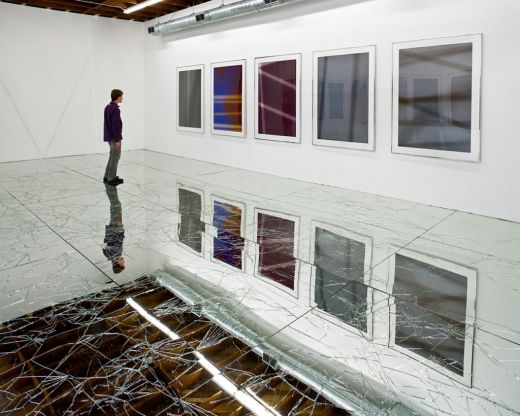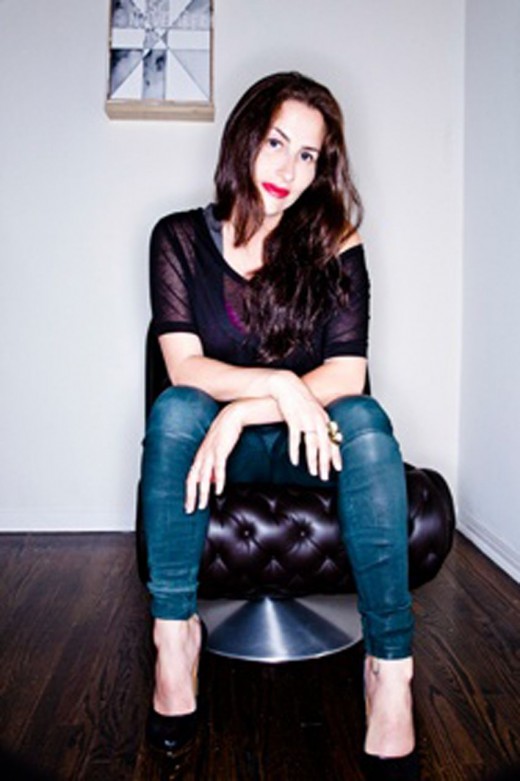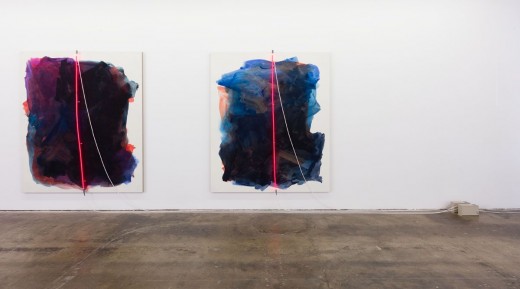Lauri Firstenberg: In Conversation With Tobias Ostrander
Tobias Ostrander

Walead Beshty, Passages, installation view, 2009. Courtesy of the artist and LA><ART, Los Angeles.
TOBIAS OSTRANDER (RAIL): You have a Ph.D. in the History of Art and Architecture.
LAURI FIRSTENBERG: Yes, from Harvard.

FIRSTENBERG: Even as an undergrad any time I wrote a paper about an artist I always wanted to animate the argument in the context of an exhibition, and even as an undergrad I knew that I wanted to work in museums. And then, in graduate school, every time I published an article it would be the premise for an exhibition. At the time I was either working with young artists in New York or doing a lot of work in South Africa, publishing new work with young artists or bringing them to New York to exhibit their work for the first time.
That really set a tone for the work we do at LAXART. Our curatorial team tends to be comprised of academics with an emphasis on research and writing. They question how their language in the context of the academy can translate outside of that context. The intention is that LAXART is surrounded by writers and researchers retaining the level of rigor that our collaborating artists expect while being accessible to a larger public. We stage lectures and conversations that could be staged in the context of a university structure, we try to maintain a level of critical discourse throughout all aspects of our programming. Oftentimes teaching goes hand in hand with curating for our team. Many of my former students have come through LAXART’s curatorial department as well.
RAIL: What made you return to L.A. from New York—was that 2003? What potential did you see in L.A. at that time?
FIRSTENBERG: I was at Artists Space at the time and it was an incredible moment there. We internationalized the program and audiences were reinvigorated. I had to come home for my family and moved quite swiftly. I remained the adjunct curator at Artists Space and I was asked to open Artists Space West. I realized that would be a dramatic decontextualization of a particular history of the space in New York but that retaining the principles of curatorial and artistic freedom and experimentation in the context of Los Angeles could fill a gap or need in the cultural constellation of the city.
When I got to Los Angeles, I realized it was my home but I had a lot to learn about how the contemporary art world was changing. This was ten year ago, so it was not what it was today. It has completely expanded and since I moved most of my colleagues from New York also moved, so there is an incredible community of curators and directors that has significantly changed the landscape.
I interviewed artists, writers, patrons who were invested in the smaller non-profit sector to try understand the problematics of L.A.’s art spaces in terms of vision, audience, and sustainability. I curated a show at LACE [Los Angeles Contemporary Exhibitions] to try to assess audiences and infrastructure and I did that at REDCAT [Roy and Edna Disney/Calarts Theater] as well and also at the MAK Center for Art and Architecture where I took a position as the assistant director and curator. At the time, I was trying to unpack why a place like L.A. doesn’t have more of a density of these kinds of spaces or why they’re temporal, and was writing about artist-run spaces and temporality as a radical strategy. The mission for LAXART is basically a series of questions inheriting the given that the non-profit model is a failed model. We put forward a series of questions and provocations to be reconsidered over time as to what a productive platform could be for artists, curators and artists.
RAIL: My next question was sort of implied in there. How has L.A. changed since 2005 when you started LAXART, and how has LAXART changed Los Angeles at the same time?
FIRSTENBERG: I think about Culver City all the time. LAXART has benefited from that location in terms of a built-in audience, and an incredible community of artists that come out for other artists and then other audiences following suit. L.A. is fickle and cultural centers tend to shift. The question of location is of interest to us as we look to our ten-year anniversary.
RAIL: Do you think you changed it?
FIRSTENBERG: We hear, particularly from the artist community, that we’ve contributed to the conversation. Also, we are surrounded by galleries who believe we created a climate of rigorous programming that has made an impact on contemporary-art discourse in Los Angeles and beyond. The museum culture has shifted and the market is expanding, so there is a great deal of activity from which to respond.

Dashiell Manley, The Great Train Robbery (Scene 3 Version A), installation view, 2013. Photo by Michael Underwood, Courtesy of the artist and LAXART, Los Angeles.
FIRSTENBERG: There’s more happening. Younger galleries are opening up with really interesting programs. Galleries from New York have created outposts in L.A.—Matthew Marks, L&M—and others are going west as well. Local galleries have expanded tremendously and often are doing the work of the institutional sector, like Regen Projects for example.
RAIL: But I think L.A. has a different kind of visibility or, for lack of a better word, sense of self- reflection or a kind of confidence. There’s always been the competition between L.A. and New York but L.A. doesn’t compete in the same way anymore. I see it more in terms of self-validation of Los Angeles in the last ten years in a very structural way—certain shows, histories being written—and I wonder how you have participated in that conversation.
FIRSTENBERG: I think we’ve participated on a small level. There is an interest. The density of artistic community in Los Angeles is exceptional. Artists are not moving out of L.A. anymore. They’re staying here because it’s affordable, there’s space to live and work and there is a vibrant community of artists and more spaces to show their work. Being an L.A. artist is productive. I just returned from New York and L.A. is everywhere—in the museums, at the fairs, in the galleries. And I think that also Michael Govan being at LACMA and Annie Philbin being at the Hammer transformed these institutions. They have cultivated a new sector of cultural philanthropists in our city. The Getty’s monumental initiative “Pacific Standard Time” did a great deal for artists by investing in and unearthing new narratives in the recent art history of the region. I think LAXART’s participation in aspects of PST, such as co-directing the PST Performance and Public Art Festival with the Getty, created an incredible opportunity to work with artists like Eleanor Antin or William Leavitt, reanimating work from the 1970s that reverberates with artists today.
Artists seem to give LAXART feedback that space is needed in the context of L.A. There used to be a logic of slowness for the creation and testing of ideas and work and the market doesn’t necessarily allow for that anymore. We’re trying to at least carve some of that out, some time for work to be made and discussed and written about— considered and digested and not just on a level of consumption.
RAIL: You have at various times collaborated with larger institutions in California like Orange County Museum of Art’s California Biennial, “Pacific Standard Time,” and the Hammer Museum. What goals have driven you to be involved in these collaborations? What are the advantages and pitfalls of these projects? What advice would you give to other small non-profits in this regard?
FIRSTENBERG: It’s a tricky question (laughs).
RAIL: I know. At a certain point is it about visibility for your institution or is it more you as a curator being interested in working on a larger scale at a certain time?

Mary Weatherford, Bakersfield Paintings, installation view, 2012. Photo by Michael Underwood, Courtesy of the artist and LAXART, Los Angeles.
So our questions in 2005—is there viability for a model like ours and is it sustainable?—are being reassessed as we approach 2015. There are different impulses contingent upon the leadership and vision. If you look at the past eight years since we opened, the spaces that have popped up have been exciting, like Human Resources, which has a focus on performance, and a forthcoming project called the Mistake Room that started out of LAXART’s temporary annex space in Hollywood. LAXART has the opportunity to consistently reinvent itself or focus on its rigorous programming and sustainability—to hand it off to a new generation of artists and curators.
RAIL: That was my question. We’ve been discussing longevity and sustainability and where are you in that process?
FIRSTENBERG: I think there’s a commitment to grow. I think the train has left the building. The program is growing, the infrastructure is building, the budget is growing, the audience is growing, and I think that right now the goal is what the next two years looks like programmatically and then The Occasional is a key focus for our curators. So, if in two years the city looks and feels different and a small hub for activity is not pressing and paramount, then we will consider flexibility and itinerancy versus growth. But my instinct is that in an expansive, sprawling city like L.A., space is important as a gathering space for discussion and interaction.
RAIL: Tell us about The Occasional. Where did that title come from? Why the push for a more international program, and what would be the scope and character of that?
FIRSTENBERG: L.A. is very invested in L.A., and L.A. is everywhere.
RAIL: It’s true.
FIRSTENBERG: But it’s a very international city. We think that our program should reflect the city and our audiences and the diversity and dynamics of the city. I think our curatorial team understands that L.A. is an extension of Mexico. The relationship between L.A. and Mexico City is a priority programmatically at LAXART. I think also some of the interests of the curators that come through—like Matthew Schum, who is focused on international travel and research.
So The Occasional, the name came from Malik Gaines, our former adjunct curator who was part of the Hammer/LAXART collaborative curatorial team for the first L.A. Biennial, “Made in L.A.” Our curatorial team came to the project with the notion of The Regional, out of discussions with artist Vishal Jugdeo in thinking about an international platform in the context of L.A. For The Occasional, the projects will happen when they need to happen; this entity will happen when it can happen. A lot of it has to do with not being bound to institutional time.
RAIL: The local art community in Miami is very young but very active; you see a lot of artist-run spaces. What do you see as the challenges of these kinds of initiatives in a young city like Miami and what advice might you have for them?
FIRSTENBERG: I just had breakfast with Naomi Fisher, from BFI, to talk about the pros and cons of becoming a formal non-profit entity or remaining a flexible project space. Looking at her space and looking at what they’ve done—it’s a nine-year project. Oftentimes artist-run spaces are temporary, as artists invest in a community and support other artists until they have to go back to focusing on their own practice. But they are going on ten years; I think that means something. Small gestures of support in the community can have a significant impact on artists-run spaces, which to me are the most dynamic and interesting. That’s where I learn the most.
It seems very exciting here in Miami. There’s a density of these kinds of artists’ experiments. Maybe that can’t be sustained, but there’s an interest in the part of the artist community to work in that vein. In Los Angeles, the activity is dispersed, not centralized, the dynamic of the landscape also affects the visibility of these types of spaces. But also, as an outsider, it’s exciting to be introduced to new work and spaces. I think there’s so much potential here.










